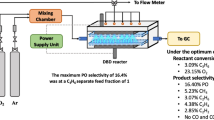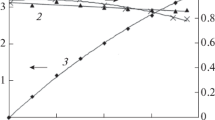Abstract
The synthesis of propylene oxide by electrolysis of dilute sodium bromide solution with propylene gas was investigated in an electrochemical ‘flow-by’ bipolar reactor consisting of six parallel fixed beds of graphite particles separated by polypropylene felt diaphragms. The reactor was operated in a single pass mode with a two-phase co-current flow of propylene and sodium bromide solution through the beds of graphite particles. The maximum pressure in the system was 2.2 atm absolute.
The effects of superficial current density (0.4–2.7 kAm−2), sodium bromide concentration (0.2 and 0.5 M), electrolyte load (4.4–13.2 kg m−2s−1), propylene gas load (0.08–1.66 kg m−2s−1), reactor outlet temperature (30 and 60°C), bed thickness (5–15 mm) and different carbon types (Union Carbide and Ultra Carbon) on the space-time yield and selectivity for propylene oxide were measured. Depending on conditions, the space-time yield for propylene oxide was between 5.5 and 97 kg m−3h−1, and the selectivity was between 55 and 87%. The current efficiency and the specific energy consumption varied from 14 to 58% and from 6 to 60 kWh kg−1 of propylene oxide. The space-time yield for propylene oxide increased with increasing current density, increasing gas flow and decreasing bed thickness.
The current efficiencies for hydrogen, oxygen, dibromopropane, hypobromite, bromite and bromate were also determined.
Similar content being viewed by others
References
M. Fleischmann, J. W. Oldfield, and C. L. K. Tennakoon,IChemE. Symp. Series 37 (1971) 153.
F. Beck, XXIVth International Congress of Pure and Applied Chemistry, Vol. 5, London, Butterworth (1973) p. 111.
C. J. H. King, K. Lister, and R. E. Plimley,Trans. Instn. Chem. Engrs. 53 (1975) 20.
J. Ghoroghchian, R. E. W. Jannson, and D. Jones,J. of Appl. Electrochem. 7 (1977) 437.
A. V. Boussoulengas, S. Edhai, and R. E. W. Jannson,Chem. and Ind. 60 (1979) 670.
P. Robertson, P. Cetton, D. Matic, F. Schwager, A. Storck and N. Ibl,AIChE Symp. Series,75 (1979) 115.
T. Bejerano, S. Germain, F. Goodridge and A. R. Wright,Trans. Instn. Chem. Engrs. 58 (1980) 28.
K. G. Ellis and R. E. W. Jansson,J. Appl. Electrochem. 11 (1980) 531.
13 (1983) 651.
R. Alkire,J. Electrochem. Soc. 120 (1973) 900.
C. Oloman,126 (1979) 1885.
A. Manji, MASc Thesis, University of British Columbia, December 1984.
M. H. Hashmi and A. A. Ayaz,J. Anal. Chem. 35 (1963) 908.
Author information
Authors and Affiliations
Rights and permissions
About this article
Cite this article
Manji, A., Oloman, C.W. Electrosynthesis of propylene oxide in a bipolar trickle-bed reactor. J Appl Electrochem 17, 532–544 (1987). https://doi.org/10.1007/BF01084127
Received:
Revised:
Issue Date:
DOI: https://doi.org/10.1007/BF01084127




